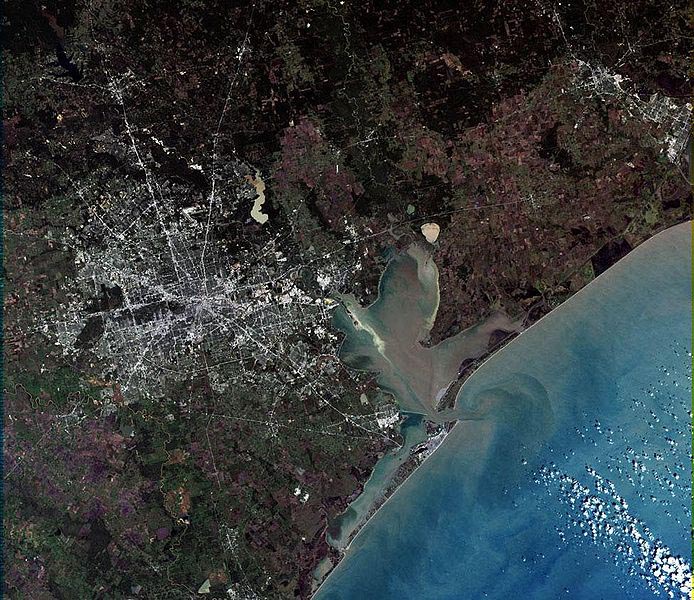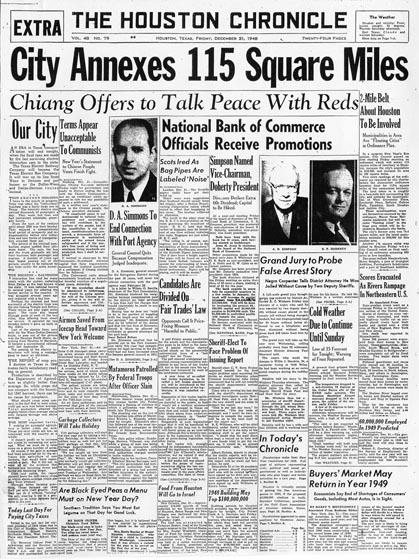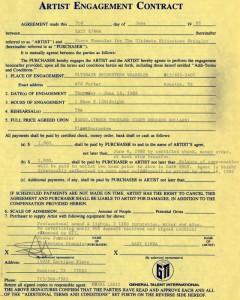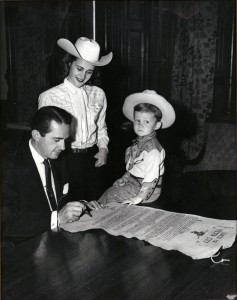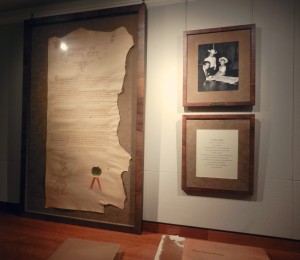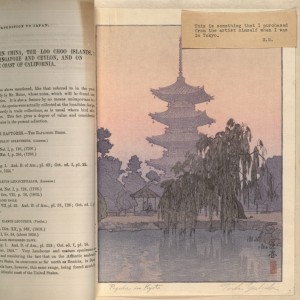
Whether it’s a rare book printing found at long last or piece of ephemera found in an archival collection by chance, those who visit the University of Houston Special Collections almost always find something they cannot wait to share with others. Here we celebrate what makes the University of Houston Special Collections so special–our Favorite Things.
The satellite view is spectacular and confirms what we already know—Houston is big. At last count, Houston’s incorporated area covers about 667 square miles. We know this because the City of Houston Planning & Development Department has created an informative slide show that illustrates the city’s ever-changing boundaries. “Annexations in Houston or How we grew to 667 square miles in 175 years” can be found online.
If you want to research urban planning in Houston the old-fashioned way—using text and images printed on paper—try the Special Collections Department at UH Libraries. I recommend the old-fashioned way because, while it is not as convenient as surfing the web, it is way more fun.
Discoveries abound in Special Collections. Every folder holds a surprise. My most recent discovery was a set of maps from the Paddock Greater Houston Convention & Visitors Council Records. As the name suggests, this collection contains records collected by Marianita Paddock from her years with the Greater Houston Convention & Visitors Council. But it also includes maps of cities and counties in Texas from the mid-twentieth century. Some of the maps are common but others are unusual, such as a 1948 Ashburn’s Map of Houston in a special edition issued for Forest Park cemetery on Lawndale.
The most significant is the City of Houston’s Zoning District Map, December 15, 1947. Houston was small once, and I don’t mean when the Allen Brothers founded it in 1836. As late as the 1940s, it was a compact city of 75 square miles. This map reminds us that in 1947 the city’s boundaries extended no farther than Kirby Drive on the west, Brays Bayou on the southwest, and Sims Bayou on the southeast. The Heights, Rice Institute, and the new Texas Medical Center were on the edge of town.
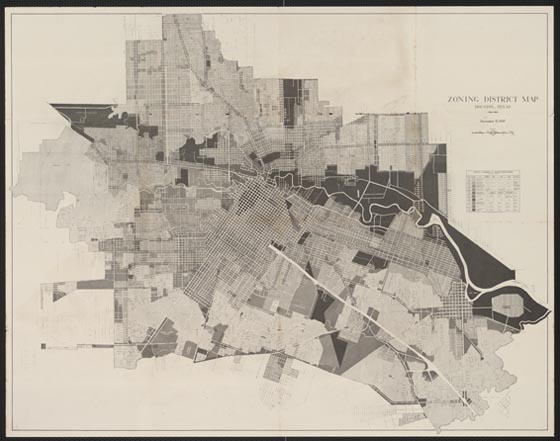
City of Houston, Zoning District Map, December 15, 1947, Paddock Greater Houston Convention & Visitors Council Records
The map is a historical footnote to the larger question of urban planning in Houston. Most people know that Houston is the largest city in the country without land use zoning. So why was the city publishing a zoning map? The answer is that it was done to educate citizens about the issues in the upcoming special election in January 1948 when they would be asked to approve a new law authorizing zoning. It’s no spoiler to say that voters rejected the law. Progressives in Houston are gluttons for punishment and tried again in 1962 and 1993. Voters were unmoved and we still have no zoning.
More importantly, the map is a detailed snapshot of the city’s boundaries, street system, and land uses on the eve of its great suburbanization. On December 31, 1948, only a year after the map was published, the city council approved an ordinance annexing a large swath of territory that more than doubled the city’s land area to 189 square miles. Houston was small no more. This was the first of many annexations, done to preserve the city’s tax base and its ability to grow.
City council waited until New Year’s Eve to drop this bombshell. The Houston Chronicle responded with a banner headline. Pasadena and other neighboring cities were not thrilled by the news. Their New Year’s hangover was beginning early and would continue for decades more.
Whether it’s a rare book printing found at long last or piece of ephemera found in an archival collection by chance, those who visit the University of Houston Special Collections almost always find something they cannot wait to share with others. Here we celebrate what makes the University of Houston Special Collections so special–our Favorite Things.
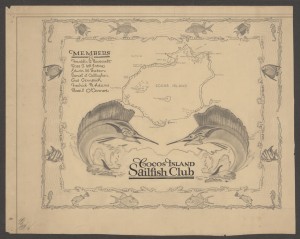
Cocos Island Sailfish Club decorative map, ca. 1934-1935, Cruiser Houston Collection
Today, one of my favorite things is also one of our newest things–the “Cocos Island Sailfish Club” decorative map.
The University of Houston Special Collections recently acquired the hand-drawn map commemorating the Cocos Island Sailfish Club, as part of the Cruiser Houston Collection. Prior to her fateful service at the outbreak of World War II, the Houston, often served as the transport of choice for its most famous passenger–President Franklin D. Roosevelt. Throughout the 1930s and 40s, Roosevelt set out on four cruises aboard the Houston. Presidential cruises in the Pacific during the years 1934 and 1935 included fishing expeditions to the Cocos, the Galapagos, and other Pacific isles.
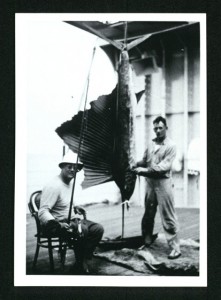
Franklin D. Roosevelt, deep sea fishing on USS Houston (Cruiser Houston Collection, high resolution download available through our Digital Library)
The Cruiser Houston Collection contains photographs documenting these excursions, including photographs of the President with his sailfish catch. Now, the addition of this particular item will provide further context for the peacetime activities of the Houston. Depicted on the commemorative map are the Cocos, accentuated by drawings of large sailfish, bordered by drawings of other imagery and fish from the tropics, as well as a named roster of “club members”: Franklin D. Roosevelt, Ross T. McIntire (Vice Admiral, personal physician of President Roosevelt), Edwin M. Watson (Major General, military aid to President Roosevelt), Daniel J. Callaghan (Rear Admiral, naval aide), Gus Gennerich (bodyguard and personal aide), Frederick B. Adams (secretary), and Basil O’Connor (legal advisor and former partner).
Those interested in getting a closer look at the Cocos Island Sailfish Club are encouraged to see it in person by visiting our reading room. Others may get a sense of the detailing of the map by viewing a digitized version, courtesy of our colleagues in Metadata and Digitization Services. Finally, those interested in more information on this item or the Cruiser Houston Collection should contact Christian Kelleher, Head of Special Collections and curator of the USS Houston & Military History collections.
Whether it’s a rare book printing found at long last or piece of ephemera found in an archival collection by chance, those who visit the University of Houston Special Collections almost always find something they cannot wait to share with others. Here we celebrate what makes the University of Houston Special Collections so special–our Favorite Things.
This past weekend’s opening of the N.W.A. biopic Straight Outta Compton has me feeling nostalgic and fawning over an artist engagement contract from the DJ Steve Fournier Papers.
DJ Steve Fournier was partly responsible for hip hop’s popular emergence in the Houston club scene during the 1980s, hosting rap contests and peppering his sets with more and more rap at Struts Disco, the Boneshaker, and the Rhinestone Wrangler. His papers include photographs, memorabilia, as well as performance contracts from emerging acts like Public Enemy, Big Daddy Kane, and Ice-T. In this particular instance, I’m fascinated by a contract drafted for a performance by “EAZY E/NWA” that maps out the terms for payment ($1,900 now, $1,900 at the show), equipment to be provided by Fournier (“2 1200 turntables, mixer and mics”), locale (“ULTIMATE RHINESTONE WRANGLER… 478 Parker,” Houston’s Northside?!), and the hour and date of the engagement (“12Midnight” on “Thursday – June 16, 1988,” over two months prior to the release of N.W.A.’s first studio album).
The incendiary Straight Outta Compton was released August 9, 1988 on Eazy-E’s Ruthless Records. It enjoyed the commercial appeal of the recently-instituted “Parental Advisory” stickers, along with the unfiltered imagery of glorified criminal violence and hedonistic misogyny that more than delivered on the promise of something truly illicit. Against a backdrop of moral conservatism and prosperity gospel of the Reagan-Bush presidential arc, that forbidden nature translated into surprising and enduring commercial success. It was a party record for our victory in the Cold War, echoing from the edge of Manifest Destiny–Compton, California. A thunderous shot from the ghetto, it was brash, boisterous, aggressive, and is now universally acknowledged as one of the most important records in the history of hip hop (see #144).
But, in 1988, I’d yet to hear those three little letters and be jolted awake by their meaning and music. So, I still can’t help but wonder if the show ever came to pass. The old Ultimate Rhinestone Wrangler (a cavernous venue for a club that easily held over 1,000, it has since been converted into a storage facility) was just a stone’s throw from where I grew up and the idea that N.W.A. might have slipped in and out without me even knowing, makes them feel both so close and yet out of reach–the one that got away, the shows one never sees. Fitting I suppose, for a group that frightened and thrilled us, both then and now. With no signature at the bottom representing “EAZY-E/NWA,” I’ll remain curious to hear from anyone who attended and got a rare, early look at “The World’s Most Dangerous Group.”
Whether you have just been introduced via F. Gary Gray’s film or you are an O.G., who has always down for the C.P.T., you’ll enjoy seeing this contract in person along with all the other trips down memory lane waiting in the DJ Steve Fournier Papers.
Whether it’s a rare book printing found at long last or piece of ephemera found in an archival collection by chance, those who visit the University of Houston Special Collections almost always find something they cannot wait to share with others. Here we celebrate what makes the University of Houston Special Collections so special–our Favorite Things.
University Archivist Mary Manning recommends a very timely item from our collections for our latest favorite–the Fiesta City charter.
It is that time of year, as spring has ushered in a veritable city-within-a-city on the campus of the University of Houston in one of our oldest traditions. Along Scott Street, in the shadow of TDECU Stadium, the student body has built, once again, our fine Fiesta City, home of Frontier Fiesta. A combination of variety shows, cook-offs, and concerts, Frontier Fiesta officially opened last night and runs through this weekend featuring entertainment for everyone.
Our University Archives preserve and make available for study the history of this tradition via the UH Frontier Fiesta Collection. Containing newspaper clippings, photographs, correspondence, show scripts, and event programs dating all the way back to 1941, the UH Frontier Fiesta Collection is open for research to anyone interested in tracing the event’s history (including the students who lead and run this massive undertaking each year).
But still, it’s not really a city, right?
Well, sometimes there is more to a name than just a cute, simple moniker.
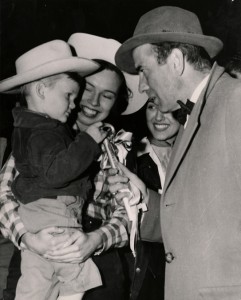
Honorary Mayor Johnny Goya III presents Humphrey Bogart with the key to Fiesta City (1952, UH Frontier Fiesta Collection)
Last spring, Manning curated an exhibition of some of these materials entitled “Frontier Fiesta: The Greatest College Show On Earth.” While many items in the exhibit garnered attention from those interested in the history of this long-standing fixture on the UH calendar, Manning noted one item of particular significance. In Houston History, reflecting on the Fiesta and what the records reveal of its history, Manning writes, “Especially noteworthy is Fiesta City’s charter drawn up by students in 1952 and branded onto a tanned cowhide by student Betty Rich and taken to Austin for Governor Allan Shivers’s signature.”
Far from any, ahem, branding ploy, this cowhide proves that a bonafide city recently sprung up on a grand swath of asphalt in the heart of the Third Ward, hosting a tradition that is uniquely Houston. Those interested in viewing Fiesta City’s charter, complete with the still-just-visible signature of Governor Shivers proclaiming it a city “happily free of municipal corruption, yankees, and other dangerous influences,” may do so in the Special Collections Reading Room during our normal research hours. Enjoy the Fiesta, and Fiesta City, Houston!
Whether it’s a rare book printing found at long last or piece of ephemera found in an archival collection by chance, those who visit the University of Houston Special Collections almost always find something they cannot wait to share with others. Here we celebrate what makes the University of Houston Special Collections so special–our Favorite Things.
Today Sara Craig, University Archives Student Assistant, offers us one of her favorites.
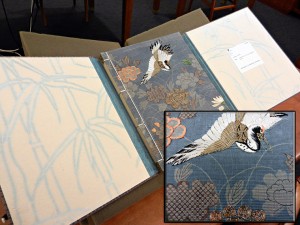
cover of the Narrative of the expedition of an American Squadron to the China Seas and Japan, v.1; inset: detail of embroidery
One of my favorite things in the UH Special Collections is the series of 13 volumes of the Narrative of the expedition of an American Squadron to the China Seas and Japan donated by Maury Maverick, a Texas Congressman in the late 1930s. The Narrative itself was compiled from the journals and notes of Commodore M. C. Perry and his officers during a trip to Asia from 1852 to 1854, first printed commercially in 1856. What makes this particular set so fantastic is the care that went into the binding and creation of each volume. Each individual book is unique, with a soft cover Japanese four-hole stab-bound (Yotsume Toji) book ensconced in a tri-fold hardcover case. These books are considered to be extra-illustrated, that is the creator of the books took the narrative and added in extra pages containing maps, prints, newspapers and other ephemera before rebinding, creating a unique and unusual set of books.
Extra-illustrated books were an unusual fad that was popular in the late 18th to early 19th century in England and the United States. Collectors of extra-illustrated books would pay to have an original printed book taken apart and rebound with added letters, maps, prints and pages from other books. Often the rebound books would be encased in gilt and leather bindings. Occasionally the extra-illustrations in a book refer to sketches, drawings and small paintings included in an original binding of a book.
Some of the extra information added, including the newspapers, deal with the aftermath of World War Two and the signing of the treaty with Japan. There are also items of a personal nature included, a letter from J. Edgar Hoover to Maury Maverick and personal letters from President Truman and his wife, Bess Truman, to Maury Maverick and his wife. Other items appear to be ephemera gathered by Mr. Maverick during his travels in Asia, postcards, Christmas cards and woodblock prints.
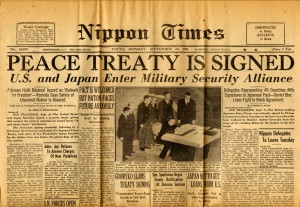
“Peace Treaty is Signed” – cover of the Nippon Times, September 10, 1951, tucked inside volume one of the Narrative of the Expedition…
What first intrigued me about these books, however, was not the information contained within. The visual appeal of the books is obvious. The beautiful book cloth covering each individual volume, each a different pattern, some small and woven, others either created using a wax-resist technique or hand-printed to appear so, is eye-catching as you walk down the aisle in the book stacks. Once you open each volume, the actual bound books are covered in a completely different and unique book cloth that complements the exterior case. Some of the interior book covers have areas of hand-embroidery; others appear to be hand-printed.
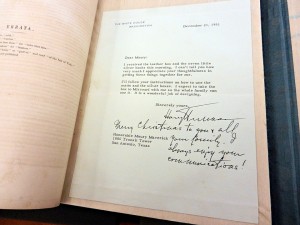
extra-illustrated: as part of the rebinding process, inserted and included is this hand-signed letter from Harry Truman to Maury Maverick (December 21, 1951)
For individuals who are interested in Asian history and culture, both historic and more recent, these volumes are particularly wonderful resources. They are also nice examples of extra-illustrated books, of interest to individuals with an enthusiasm for unusual books or artists books. Even fans of scrapbooking will find looking through this set of books might give them ideas for future projects.
